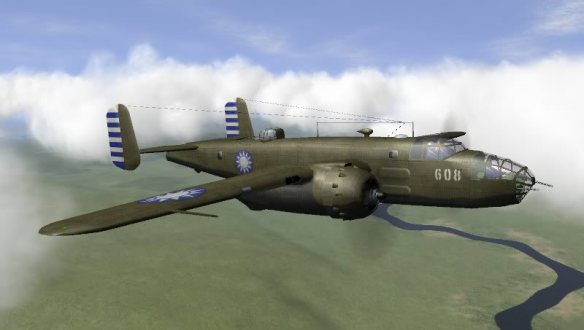B-25s 1st BG CACW
In the six months following Japan’s attack on China in July 1937, the best units of the Chinese Air Force (CAF) were destroyed. In 1938, Claire L. Chennault, a civilian adviser to the CAF, assembled an international squadron of pilots as flight leaders for Chinese units. The Japanese A6M2 Zero, introduced in 1940, was superior to CAF aircraft. In October 1940, Chennault visited the United States in search of planes and pilots; the result was the American Volunteer Group (AVG)—military pilots who resigned their commissions to fly for China—and 100 P-40 aircraft.
The AVG was disbanded on 4 July 1942 and replaced by the China Air Task Force (CATF) under then-commissioned Brigadier General Chennault. The CATF consisted of four P-40 squadrons of the 23d Fighter Group plus the B-25s of the 11th Bomb Group. Their performance convinced General Henry H. “Hap” Arnold, chief of the U.S. Army Air Corps, of the benefits of providing combat aircraft for Chinese pilots.
The Chinese-American Composite Wing (CACW) was conceived by Chennault when the U.S. Fourteenth Air Force was formed in March 1943.As Chinese pilots lacked training and confidence to engage the enemy, the plan was to have an American commander, assisted by a staff of Chinese officers, head a special unit composed of Chinese and American pilots and crews. CACW plans called for a four squadrons of fighters (80 planes) and four squadrons of bombers (40 planes), all units of the CAF, to be under Chennault’s command.
The 1st Bomb Group and the 3d Fighter Group of the CAF were formed on 31 July 1943, after American pilots arrived at Malir, India. One hundred Chinese cadets returned from training in the United States at Luke Air Advanced School to fly for the CACW. Training began at Malir using old AVG P-40s and B-25s that had been used in China. The Chinese and American officers had segregated facilities, and each maintained separate quarters and mess from enlisted personnel. The CACW was activated on 1 October 1943, shortly after 24 new P-40Ns and 12 B-25s were deployed to China; three additional squadrons of the CACW trained at Malir.
In November 1943, the 2d Bomb Squadron began combat operations; a Thanksgiving Day raid on Japan’s largest air base in Formosa (Taiwan) shot down 14 Japanese planes and destroyed more than 50 without loss of any CACW planes. CACW pressure on Japanese forces in eastern China prompted Japan’s Operation ICHI-GO to capture Chennault’s eastern China airfields employed for B-29 bombing raids on Japan after June 1944. By late December 1944, as CACW pilots began the transition to the longer-range P-51C Mustangs, the CACW had lost 20 fighters to Japanese pilots and 35 fighters and eight bombers to enemy ground fire; no bombers were lost to Japanese interceptors, a tribute to the B-25 crews and the fighter escorts.
The CACW unofficial combat record included 190 Japanese aircraft destroyed in the air, 301 on the ground; more than 2,500 vehicles were damaged or destroyed; many bridges, railroads, and enemy facilities and troops were destroyed; and several hundred thousand tons of shipping was sunk. The CACW produced eight air aces, including three Chinese aces. Chennault’s experiment yielded substantial results before it was disbanded on 19 September 1945.
References
Chennault, Claire L. Way of a Fighter: The Memoirs of Claire Lee Chennault. New York: Putnam, 1949.
Molesworth, Carl, and S. Mosely. Wing to Wing: Air Combat in China, 1943–1945. New York: Orion Books, 1990.
